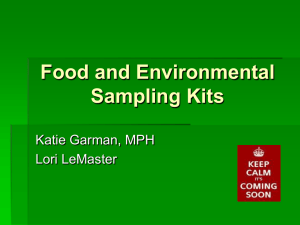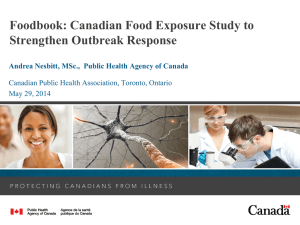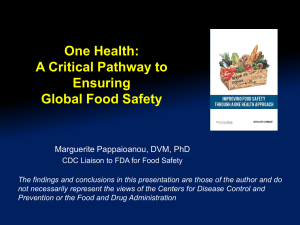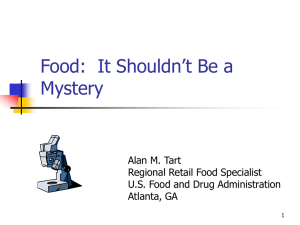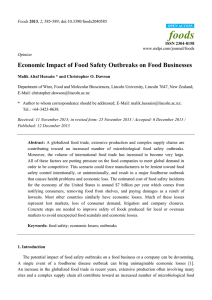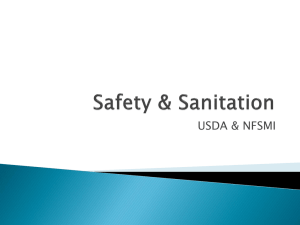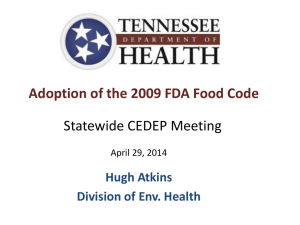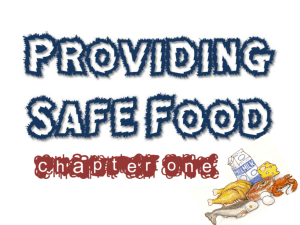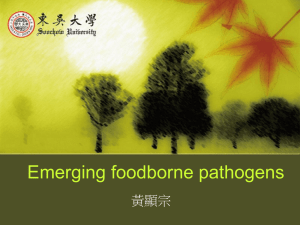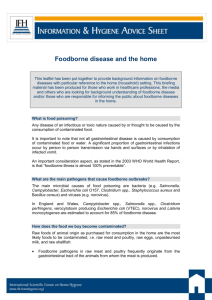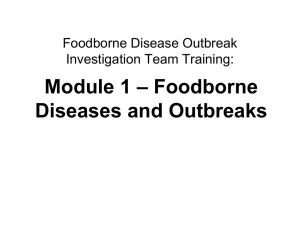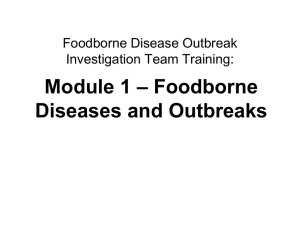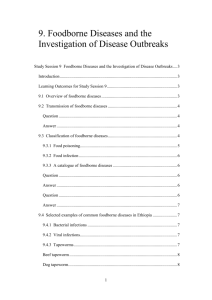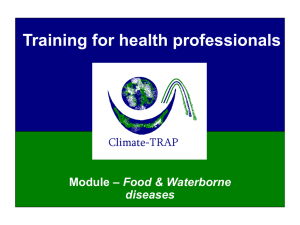Food Safety
advertisement
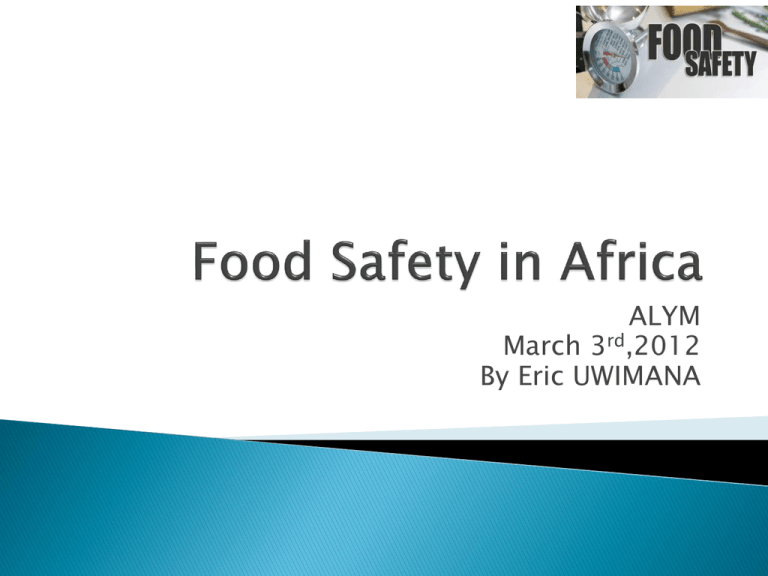
ALYM March 3rd,2012 By Eric UWIMANA Food safety - assurance that food will not cause harm to the consumer when it is prepared and/or eaten according to its intended use. Definition of foodborne illness: Foodborne illnesses are defined as diseases, usually either infectious or toxic in nature, caused by agents that enter the body through the ingestion of food. Every person is at risk of foodborne illness. Foodborne diseases are a widespread and growing public health problem, both in developed and developing countries. Salmonellosis is a major problem in most countries. Salmonellosis is caused by the Salmonella bacteria and symptoms are fever, headache, nausea, vomiting, abdominal pain and diarrhoea. Examples of foods involved in outbreaks of salmonellosis are eggs, poultry and other meats, raw milk and chocolate. Infections due to enterohaemorrhagic (causing intestinal bleeding) E. coli, e.g. E.coli O157, and listeriosis are important foodborne diseases which have emerged over the last decades. e. Coli Although their incidence is relatively low, their severe and sometimes fatal health consequences, particularly among infants, children and the elderly, make them among the most serious foodborne infections. Naturally occurring toxins, such as mycotoxins, marine biotoxins, cyanogenic glycosides and toxins occurring in poisonous mushrooms, periodically cause severe intoxications. Unconventional agents such as the agent causing bovine spongiform encephalopathy (BSE, or "mad cow disease"), is associated with variant Creutzfeldt-Jakob (vCJD) Disease in humans. Consumption of bovine products containing brain tissue is the most likely route for transmission of the agent to humans. Persistant Organic Pollutants (POPs) are compounds that accumulate in the environment and the human body. Known examples are Dioxins and PCBs (polychlorinated biphenyls). Exposure to POPs may result in a wide variety of adverse effects in humans. Metals: such as lead and mercury, cause neurological damage in infants and children. Exposure to cadmium can also cause kidney damage, usually seen in the elderly. These (and POPs) may contaminate food through pollution of air, water and soil. Food safety Other major concerns Natural disasters the importance of food safety is often not well understood. However, food safety is of critical importance to Africa because of its aggravating impact over the above listed concerns. Communicable diseases Political instability Food insecurity Dominant government and media agendas The 1996 World Food Summit Plan of Action recognized the importance of food safety, as it defined food security as: “…when all people … (have) access to sufficient, safe and nutritious food …”. improving food safety also reduce food losses and increase food availability. countries that are able to ensure safe food can take advantage of international trade opportunities, thereby increasing income levels. For example, Kenya was able to increase its fish exports to the EU from 742 metric tons in 1999 to 2 818 tons in 2001 as a result of strengthening their food safety measures. Unsafe food causes many acute and life-long diseases, ranging from diarrhoeal diseases to various forms of cancer. WHO estimates that foodborne and waterborne diarrhoeal diseases taken together kill about 2.2 million people annually, 1.9 million of them children. It is estimated that more than 70% of the approximate 1.5 billion episodes of diarrhoea that occur in the world annually are caused by biological or chemical contamination of foods. food-borne illnesses contribute to decreased worker productivity, disability, and even early death, thus lowering incomes and access to food. Food-borne illnesses also contribute to human suffering in the region. incidence of diarrheal diseases in African children, estimated as 3.3 to 4.1 episodes per child per year. It is estimated that 800,000 children in Africa die each year from diarrhea and dehydration Persons suffering from diseases such as HIV/AIDS, tuberculosis, malaria, and other ailments affecting the region are at a greater risk to be debilitated by unsafe food. Equally, persons suffering from foodborne illness are more likely to contract other communicable diseases. Furthermore, food-borne diseases are one of the most important underlying factors for malnutrition and, indirectly, for respiratory tract infections in developing countries. Thus, the assurance of safe food is essential to improving the quality of life for those already affected by disease. Cholera is a major public health problem in most African countries. In addition to water, food is an important vehicle of transmission. Different foods including rice, vegetables, millet gruel and various types of seafood have been implicated in outbreaks of cholera. Refrigeration, freezing, alkaline pH, high concentration of carbohydrate, humidity and absence of competing flora enhance the survival of V. cholerae in food. Survival of V. cholerae is shorter in food with acidic pH. a cholera outbreak in Zambia wherein between 28 November 2003 and 23 February 2004, 4343 cases and 154 deaths were reported. A case-control study showed that consumption of raw vegetables was significantly associated with cholera. A bulk of the foodborne disease outbreaks are attributable to poor hygienic practices and improper handling of food. Undoubtedly, adequate personal hygiene practices are essential in reducing the risks of a foodborne illness. Hand washing is one of the most effective and cheapest measures against infections and foodborne diseases. Did you know?? that the simple act of washing hands with soap and water reduces incidents of diarrhoea from shigella and other causes by up to 35 percent. Mycotoxins are chemical substances that contaminate various agricultural commodities, either before or after harvest . The mycotoxins of public health importance within the region is aflatoxins. It is produced by Aspergillus flavus and A. parasiticus. There are different type of aflatoxins; the most dangerous being aflatoxin B1 Under favourable temperature and humidity conditions these fungi grow on certain foodstuffs, most commonly groundnuts, dried fruit, tree nuts, spices and cereals (3). There is compelling evidence of the association between exposure to aflatoxins and primary liver cancer. Aflatoxin are toxic and carcinogenic byproducts of fungi that colonize maize, groundnuts and other crops in 2004, 123 deaths were reported in Kenya due to Aflatoxin acute intoxication. process of finding a sustainable solution to fungal contamination and mycotoxin production in foods, including aflatoxins is underway in research. http://www.niehs.nih.gov/health/impacts/aflatoxin/index.cfm Records indicate that nearly 30 out of the 46 countries of the region are currently grappling with natural or man-made disasters. Records further indicate that while Africans constitute only 12 percent of the global population, around 28 percent of the world’s 11.5 million refugees and just under 50 percent of the world’s 20 million internally displaced persons (IDPs) are to be found in Africa Disasters, both natural and man-made have profound effects on food safety. Conditions in refugee camps are prone to outbreaks of foodborne disease. Environmental contamination and improper food handling increases the risk of epidemics such as cholera. A major outbreak of cholera in 1994 devastated Rwandese refugee camps in Zaire, (Democratic Republic of the Congo) where an estimated 70,000 cases of diarrhoeal disease (mostly cholera) occurred in Goma with high fatality rate. The issue of genetic engineering has received widespread attention and remains a controversial issue. Arguments evolve on the possible long- term health and environmental risks of Genetically Modified (GM) crops/foods. The direct consequences (e.g. nutritional, toxic or allergenic effects) of the presence in foods of new gene products encoded by genes introduced during genetic modification. The consequences of gene transfer to gastrointestinal microflora from ingested genetically modified foods or food components derived from them. The potential adverse health effects associated with genetically modified food microorganisms. By 2015, it is expected that one city in subSaharan Africa (Lagos) will have a population of more than 10 million inhabitants, and 70 cities will have populations of more than 1 million. Urban poverty rates are reported to be 90% in Latin America, 45% in Asia and 40% in Africa the latter is quickly rising. The informal food trade (street food) has fast emerged as a livelihood strategy and source of inexpensive food for many poor households. A mini-census and a survey by the National Resources Institute of 334 street vendors in Accra, Ghana indicated that the street food sector employs over 60,000 people and has an estimated annual turnover of over US$100million. However many diseases outbreaks are have been linked to contaminated street food. A study on the microbial quality of street foods in Accra, Ghana found evidence of Shigella sonnei,enteroaggregative Escherichia coli and Salmonella A study conducted in Accra, Ghana found evidence of lead and pesticide (chloropyrifos) contamination in waakye, (Ghanaian dish made from rice and cowpea), and fufu Ghana Street food in There is a need of effective FSMS in Africa Although the situation in every country is affected by the particular country conditions, some common principles and components of an effective food safety system are generally needed in each country. Here is as discussion of main component of an FSMS situation. In general, food safety concerns are not adequately addressed in national governmental policies in most African countries; therefore, coordinated and sustainable approaches to the holistic management of food safety cannot be adopted. As previously indicated, most countries of the region do not appreciate the major public health and economic implications of food safety, so food safety remains a low priority in national policy making. Food legislation that is in line with international requirements (Codex) is lacking in many African countries. A survey report from the. WHO African Region indicated that 45 countries have proposed food control legislation, but only 13 countries have enacted any laws The existing food legislation is outdated, inadequate, fragmented and can be found in various statutes and codes, creating an evitable confusion among food control enforcement agents, producers and distributors. Globalization of food markets compels nations to develop food standards that are responsive to the needs of users as well as being accepted and recognized internationally. The WTO SPS Agreement stipulates that national sanitary and phytosanitary standards that are based on internationally agreed Codex Alimentarius, IPPC or OIE standards do not require further scientific justification. According to Fao only 16 countries out of 54 (30%) have national standards bodies that establish food standards. While there is an almost universal agreement that a sound scientific risk assessment is an essential part of the basis for any food safety risk management decision, meeting the need for competent, timely and independent risk assessments presents a considerable challenge to most African countries. Risk assessments are needed for establishing relevant food safety legislations, food inspection priorities and other food safety policies. FAO and WHO have recently developed a Food Safety Risk Analysis Manual Food inspectors in Africa suffer generally from ◦ ◦ ◦ ◦ (i) a low professional status (ii) a lack of logistical support (iii) the cumulative tasks often requested from them Unfortunately, food control laboratories in the African region are generally very weak Only a few of the testing laboratories in Africa are accredited for specific tests in accordance with the quality, administrative and technical requirements of ISO 17025, the international standard that provides general requirements for the competence of testing and calibration laboratories. There is lack appropriate knowledge and expertise in the application of modern practices and food hygiene in food production, processing, and marketing . Some countries that actively export products to high-income countries from particular sectors, such as fish, horticultural crops and meat, do have adequate training and support for industries in those sectors. Est African tea trade staff The information network is still lacking in many countries The information network helps To provide balanced factual information to consumers and the media; to supply of information packages and educational programmes for key officials and labourers in the food industry; the provision of reference literature to extension workers in the agricultural and health sectors; sharing relevant food safety information with other countries, especially within the region. http://www.thefoodsafetynetwork.co.za/ It is also essential that governments share information with other countries within the region, as well as with countries outside the region. Also, many countries recognize the importance of sharing information on food imports that are rejected due to inferior quality or safety that corrective actions may be taken. no single country in the region has established on-going educational programmers for government food control officials, food industry officials and/or consumers. The importance of consumer education in the prevention of food-borne illness is universally recognized. When consumers are quality and safety conscious, they are able to complement the efforts of food control agencies in encouraging the food industry to provide good quality and safe food. Assuring food safety in a global economy requires a high degree of communication, coordination, and cooperation within and between countries. very few countries in the region currently have effectively functioning coordination mechanisms. As previously indicated, many food-borne disease incidents are reported every year in Africa. However, it is extremely important to note that most cases of food-borne disease in the region are not reported, so the true extent of the problem is unknown. Most countries in the region (48 out of 53) are members of the Codex Alimentarius Commission and have established National Codex Committees and National Codex Contact Points Only a few countries in the region have established regulatory frameworks concerning foods derived from modern biotechnology, including Genetically Modified Organisms (GMOs). Most of the countries are, however, signatories to the Cartagena Protocol on Biosafety . With the rapid development of the application of modern biotechnology in food production, it is important that each country of the region determines its policy in this field. Because of the trans-border effect of GMOs, it is essential that such policies are harmonized subregionally to ensure effectiveness. Many challenges, need to be addressed to help ensure food safety: the globalization of trade in food, urbanization, changes in lifestyles, international travel, environmental pollution, deliberate contamination and natural and manmade disasters. The food production chain has become more complex, providing greater opportunities for contamination and growth of pathogens. Many outbreaks of foodborne diseases that were once contained within a small community may now take on global dimensions. http://www.fao.org/docrep/005/Y1579E/y1579e02.ht m#bm2.3 http://www.afro.who.int/en/clusters-aprogrammes/hpr/food-safety-and-nutritionfan/programme-components/food-safety.html http://ipsnews.net/africa/nota.asp?idnews=52713 http://www.who.int/foodsafety/publications/biotech/2 0questions/en/ http://www.niehs.nih.gov/health/impacts/aflatoxin/ind ex.cfm

